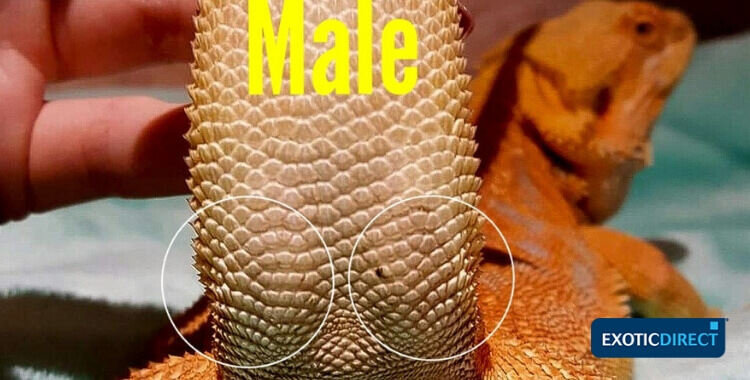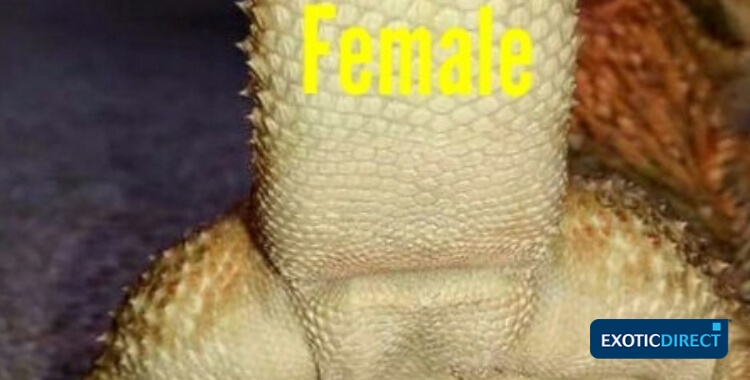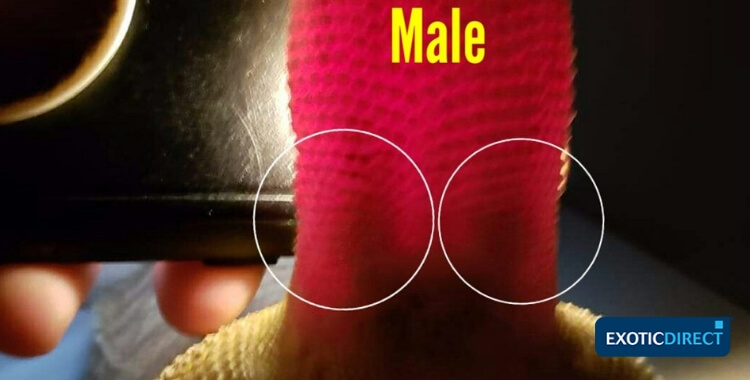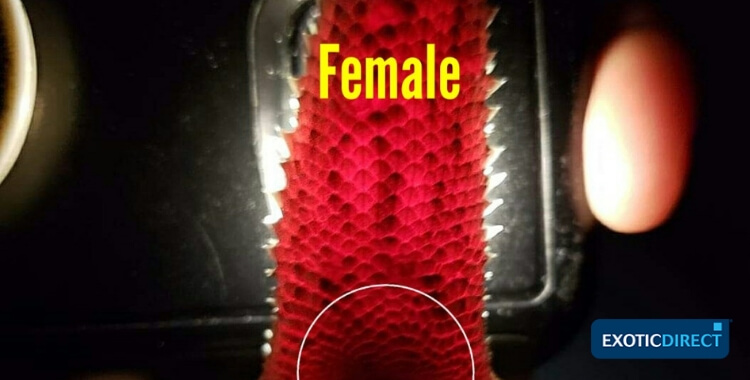Do you know how to tell the sex of your Beardie? Pete Hawkins explains how….
Is your Bearded Dragon insured? Get a quote for £1,000 of vet fees, death and theft cover. Vet fee cover only also available | We’ve been insuring exotic pets since 1996 | Check out our customer reviews on Feefo.
Male gender | Female gender | At what age can you tell the gender? | Bearded Dragon gender and behaviour | Is a male Bearded Dragon bigger than a female? | Can you keep males and females together? | Should I get a male or female beardie?
Own a cat or dog? Get pet insurance that covers up to £15,000 in vet fees every year, including dental for illness and accidents with British Pet Insurance.
There are a couple of ways to tell the sex of your Bearded Dragon and both involve looking at what are called, the ‘hemipenal bulges’.
Method one:
The first, and easiest way is to place your Bearded Dragon on a flat surface and lift the tail up 90º.
Then look above the vent, tail side, not leg side of the vent, which is a common mistake by many.
Male gender
What you’ll notice if it’s a male are the two hemipenal bulges on each side of the tail base.
 Photo courtesy of Lina Kalendraite, with thanks – A male dragon will have two bulges on his tail base.
Photo courtesy of Lina Kalendraite, with thanks – A male dragon will have two bulges on his tail base.
Female gender
For a female, there will be just the single bulge in the centre.
 Photo courtesy of Alyssa Iniguez, with thanks – A female dragon has one single bulge under her tail.
Photo courtesy of Alyssa Iniguez, with thanks – A female dragon has one single bulge under her tail.
And that’s all there is to it. Simple really.
Method two:
Exactly the same as above in beardie positioning and tail lifting, but this time in darker conditions.
Use a flash-light (phone flash-lights work great) and shine through the base of the tail, above the vent on the tail’s topside, and look at the underside.
If it’s a male, the two mentioned hemipenal bulges should be easily visible.
 Photo courtesy of Lindsey Dutchess, with thanks -Torchlight can help you see a male’s hemipenal bulges
Photo courtesy of Lindsey Dutchess, with thanks -Torchlight can help you see a male’s hemipenal bulges
If female, you will not see the two bulges, just the single centre bulge.
 Photo courtesy of Lindsey Dutchess, with thanks – You can see this is a female dragon with one bulge
Photo courtesy of Lindsey Dutchess, with thanks – You can see this is a female dragon with one bulge
At what age can you tell if a Beardie is male or female?
I’ve had many clutches of dragons over the years. Hundreds in fact, and many I could sex in the first week or so, using method one above.
But if you wait till around 8 to 12 weeks, you will be 100% certain.
Things are harder to see with a fast, wriggly little dragon and they often don’t sit still long enough for you to get a good look at.
But by the time they hit that two to three month mark they have calmed quite significantly, making it so much easier to view and use either of the given methods.
And of course at three months+ they are ready to be given new homes.
Bearded Dragon gender and behaviour
It is thought by many that you can tell the sex of a beardie purely by how it behaves. They say, “only males black-beard; that females dig or that males are bigger than females”. Nonsense!.
Black beard: All bearded dragons will have the ability to black-beard. It’s what they do, and for many reasons; dominance, mating, illness, mood, to name just a few.
Digging: Also the digging thing is incorrect. Sure, a female will dig when it’s wanting to lay eggs, that’s a guarantee.
But all beardies will dig as it’s what they do on an evolutionary level. They dig to forage for food, or to make a burrow for sleeping. Whether male or female they all dig or simulate digging.
Is a male Bearded Dragon bigger than a female?
As for the actual size differences between male and females, there are just too many other factors in a young dragon’s development in captivity to warrant this being a legitimate observational fact.
Factors like diet; heat; UVB; dominant or dominated, and of course, genetics. So there is no real reason a male or female would grow faster or bigger in captive conditions.
Although it’s worth noting, many females have what I call “the egg bearing belly”. This being quite a soft pudgy belly – best to hold eggs in (more on eggs later).
But in wild conditions, it has been noted that the males do tend to be larger in length. Although still often quite varied.
Can you keep a male and female Bearded Dragon together?
The simple answer is no.
While there is a benefit of keeping a ‘clutch’ of dragons together in those first three months, as food competition can lead to a greater feeding response, the problems can outweigh the benefits.
Less dominant dragons can struggle to get food, leading to smaller and frailer dragons. This is why sometimes you’ll see dragons under three months suffering with these and eating issues.
After three months the risk is far more apparent. Dominant behaviour becomes more problematic as stronger beardies grow in confidence, and they become more territorial.
And this is a dragons nature by design, solitary and territorial. So housing a solitary animal with other beardies can by nature, lead to huge problems, injuries. Even death.
Some will say you can keep two females, and one male. Or, one male and one female and so on. Don’t do it.
Although they may seem okay when you are watching, I can assure you this is a stressful situation.
When that male wants to mate, the female will have little choice. And bearded dragon mating can be quite aggressive as they can get hurt. Ultimately, it’s all very stressful for both dragons.
And as we know, for any species, stress = illness, and that’s not a good thing.
Also the things many people see as ‘cute’ – like one dragon laying on-top of another, is not in fact cute. It’s not ‘cuddling’. This is dominant behaviour where the top dragon is sourcing all the heat and UVB for itself. There is absolutely nothing else going in in this situation.
So with a species that only really come together for mating in wild conditions, putting more than one in an enclosure is a possible recipe for disaster.
I know many pet-shops and zoo’s house multiple beardies together, however there is a reason for both.
The pet-shop is a stop-gap. The dragons won’t be there to long before being homed. I know it’s still not ideal, but any good shop will monitor all the dragons, and spot any over dominant behaviour.
Zoo’s, well most good zoo’s, have extremely large enclosures. Much bigger than our minimal 4ft x 2ft x 2ft enclosure we have at home.
In these large enclosures they will have multiple UVB exposure areas, multiple basking areas and multiple feeding areas. All aid in the keeping of a territorial reptile.
Like a Big-Brother house analogy I used once in my Bearded Dragon Facebook group:
“You put several people, with the freedom to roam where they want. It’s unlikely they’d ever cause issue to each other.
You put those several in the big brother house…….It’s going to seriously kick-off eventually”.
This is much the same with our Dragons 😉
Should I get a male or female bearded dragon?
This is entirely your choice, but there are some male and female trait’s that are worth noting.
Males will, at least once yearly become agitated and restless when in ‘mating season’.
This can be any time of year, and is very much dependent on the temperatures outside and in-turn, your geographical location.
But I find this time to be the spring-time here in the UK. Just after waking from Brumation (see my previous article on Bearded Dragon Brumation with ExoticDirect).
This “glass surfing all-day” will last a week or so, then they should revert to the calm demeanour of the dragon you are used too.
With females of course comes egg laying. Many people get put off buying females because of this, which I personally think is totally unfair on these beautiful reptiles.
Eggs can come anytime from 10 months onwards, and a female will lay three or more clutches per year, even if they have never even set eyes on a male. So it’s a case of being prepared.
All that being said egg laying is never really an issue if you provide what is needed – a dig box, privacy, hydration, and the correct diet. The rest is down to that beardie.
So, male or female, you’ll have a little character in your life, full of energy and mischief.
I do love a bearded dragon 🙂
Pete Hawkins runs the Bearded Dragons Network Facebook group. He’s also written several articles for ExoticDirect and has written for Reptile Apartment and Practical Reptile Keeping.
Get a quote to insure your Beardie for £1,000 of vet fees. Up to three beardies per policy.
Own a cat or dog? Get pet insurance that covers up to £12,000 for dogs and £9,000 for cats in vet fees every year, including dental for illness and accidents with British Pet Insurance.
Pete Hawkins may receive commission for pet insurance sales that result from you clicking on a link within this article.

